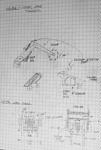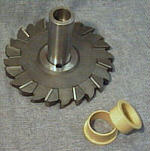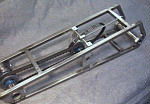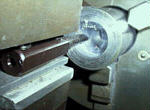| Home > Robots > Alexander > January 1997 | |
| January 1997 | |
![[January]](or-jan.gif)
Regarding the pictures: I take them of elements that I think are intersting. If you think differently, let me know and I'll try to post additional details. If you buy a T-shirt you might even get special treatment.
 |
This is where it all started. While sitting in a diner eating a burger I was mezmorized by a huge Caterpillar backhoe working on the street outside. A weapon idea! Here is the sketch I made of the "Cutting Crane" between french fries. The part dimensions below were added as the design progressed. The Crane has three axis of movement, two in the shoulder and one in the elbow. This flexibility is to afford maximum placement of the cutting head on the target. |
 |
The whole point of the Crane is to position this cutting head for maximum effect. The cutter is made of really hard tool steel, 56 Rc. In February it will take a trip to a shop in Pasadena where a CO2 laser will bore a number of lightening holes in the web (to reduce weight.) The current design has it spinning at better than 1000 RPM with a 1.25 horsepower drive. And yes, the teeth are really sharp. The yellow cylinders on the bottom are plastic bearings from Igus. Apart from the need to maintain tight tolerances (+/- 0.0005") on the cups they are pressed into, they are unreal. Made of a Nylon and Kevlar blend impregnated with a solid lubricant, they have reduced the overall bearing-weight of the Ax by 8 lb. |
 |
The completed "upper arm" of the Crane. Square tube steel comprises the frame and 1018 mild carbon steel holds the bearings in place at the rotation points. The elbow joint (lower left) is quite complex. Not only does the forearm hinge here, but in precise axial alignment one stage of the speed reducer spins down the middle. Yes, it was quite an exercise in jig fixtures to keep everything from moving around as I welded it. A step of only 0.003" will increase the bearing coefficient of friction from 0.04 to about 0.30 which turns the joint into a fancy heater. |
 |
The power drive will be mounted in this open area near the base, far away from the damage being rendered at the cutting head. A three stage belt reducer drops the 12,000 RPM generated to something more manageable for a cutter of this size, while increasing the torque. The belt sizes grow progessively larger as their linear speed decreases and internal tension increases. The final drive to the head is a pair of 0.375" pitch synchronous drive types. The fancy Aluminum assembly is a movable center for the first stage axle. |
 |
I got a quick clue on axle design from the Ag project: make them hollow to save weight. Here I am boring out the 1.250" steel axle for the cutter. I bought a lathe for this project and it's proved invaluable. Without this machine I wouldn't have even tackled this design. |